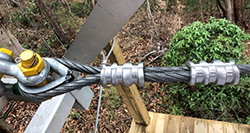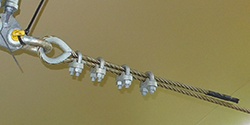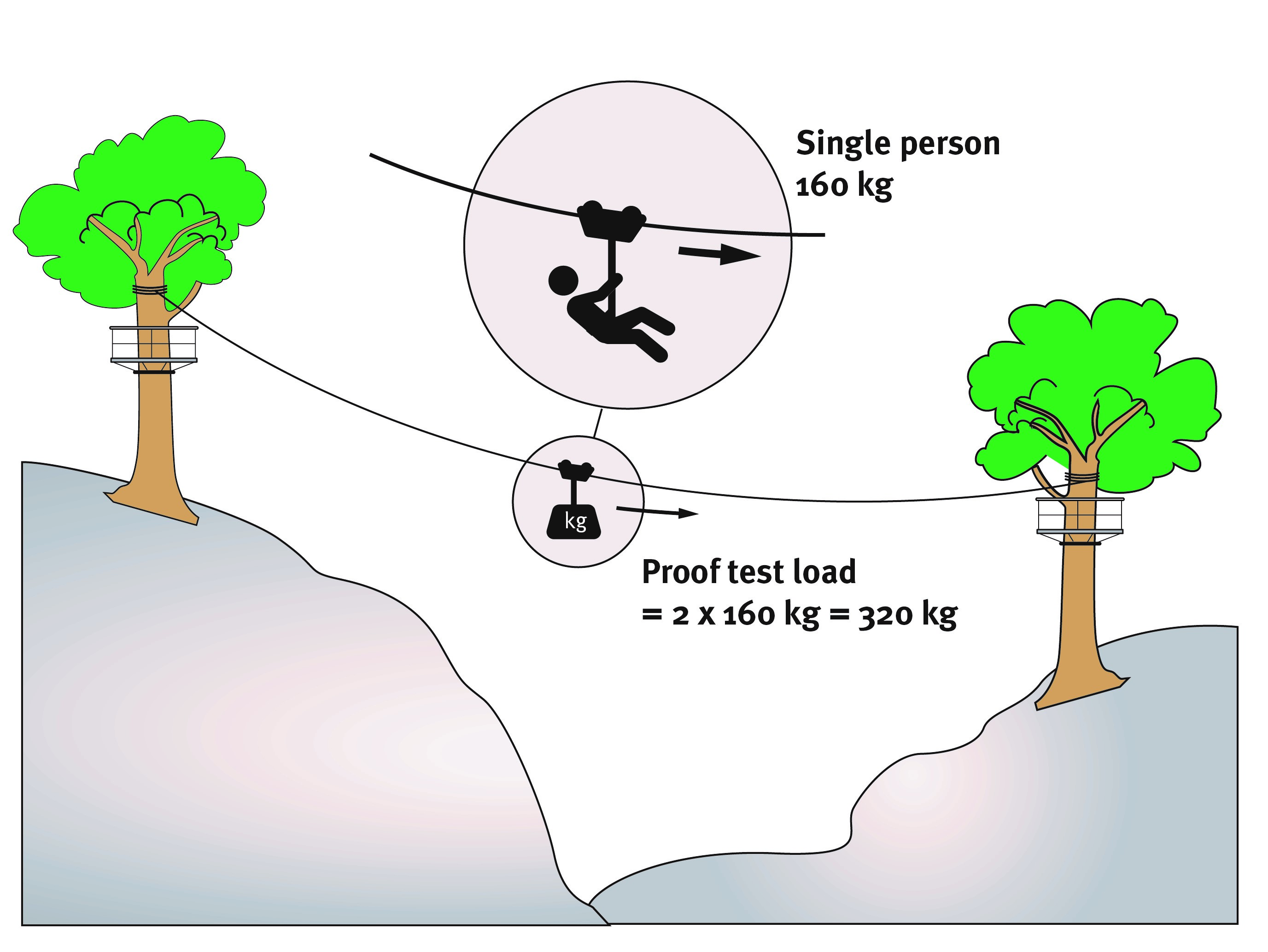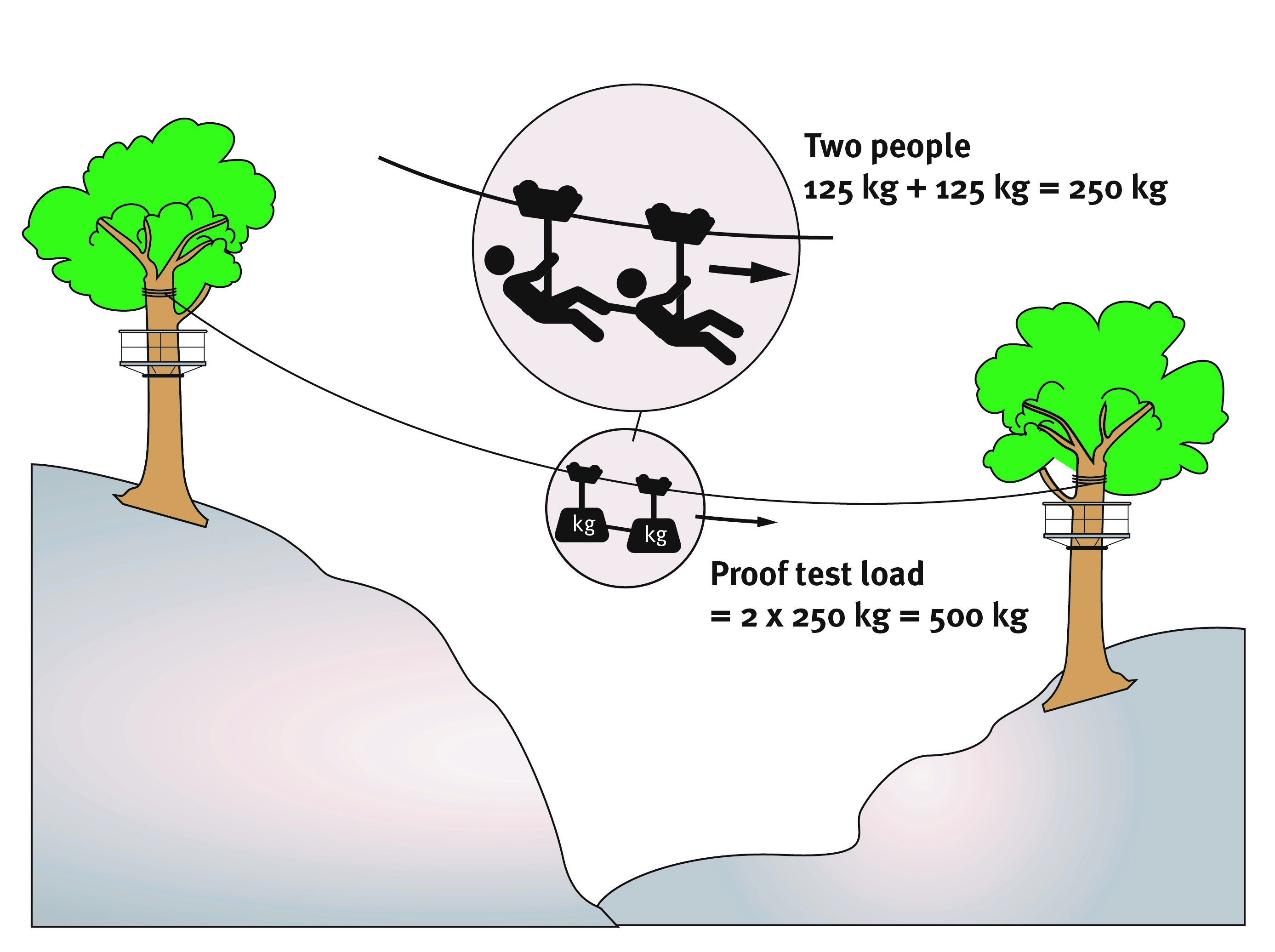Zip line terminations
Issued: 9/12/2019
Last Updated: 9/12/2019
Purpose
The purpose of this safety alert is to inform zip line owners, operators, engineers and riggers of the risk of failure of zip line terminations and to provide guidance to help prevent the failure of zip lines.
A zip line consists of a steel wire rope that is suspended between two points, along which one or more people travel while suspended from trolleys. Zip lines are also known as flying foxes.
This safety alert provides information on zip line terminations and does not apply to other suspended rope applications.
Background
In October 2019, an 86-metre zip line termination failed and two patrons dropped to the ground, causing fatal injuries to one and serious injuries to the other. The two patrons were travelling along the zip line, one behind the other, with a rope link between them.
Rope terminations on zip lines generally use either of two basic types of rope termination:
- pressed ferrule or swage type rope terminations (refer Photograph 1)
- wire rope grips (e.g. bulldog grips) (refer Photograph 2).
Both pressed ferrule terminations and wire rope grips rely on the application of pressure between two parallel sections of wire rope, the rope tail and the loaded section. The applied pressure creates frictional resistance to avoid failure of the termination by preventing relative movement.
Over time the wire rope characteristics may change (e.g. the rope diameter may reduce) so that a termination which previously withstood applied loads may suddenly slip and cause failure of the zip line.
Visual inspection of rope terminations may not be adequate on its own as a means for verifying the ongoing adequacy of terminations.
The rope tension in zip lines can be extremely high and includes:
- pre-tension applied to the rope during set up (to reduce sag, i.e. 'catenary')
- tree movement
- the additional loads applied by patrons using the zip line.
It is important to note that loads applied by patrons to the zip line and its end anchorages will be many times their self-weight due to the triangulation effect of the load. For example if a 100 kg patron uses a zip line, the additional tension applied to the zip line and its anchorages could be more than five times greater (i.e. potentially in excess of 500 kg force).
 Photograph 1: Pressed swage type rope termination (example only) |  Photograph 2: Rope termination using wire rope grips bulldog type (example only) |
Contributing factors
The incident is being investigated. It appears that the rope grip type termination at the top end of the zip line failed, allowing the zip line to disengage suddenly and causing both patrons to hit the ground.
Action required
Australian Standard AS 2316.2.1:20161 refers to the design of zip lines. There are several other Australian Standards relating to lifting and rigging gear that provide information on design and testing. The principles in these standards can also be applied to zip lines.
All zip lines
All zip lines, including the zip line terminations and anchorage systems, should be designed or verified by a suitably qualified Registered Professional Engineer of Queensland (RPEQ). The engineer should verify all components of the zip line including the methods used to install the hardware. The engineer should provide written instructions on periodical inspection methods for the zip line along with any limitations on its use (e.g. loading, wind).
All connections should comply with recognised Australian or International Standards for lifting or climbing equipment. Connections should also comply with sound rigging practice. This includes setting up zip lines using:
- thimbles on all steel wire rope terminations
- load-rated and moused shackles (i.e. to prevent the pin coming loose)
- load-rated chain that has been proof loaded before use
- load-rated turnbuckles and connectors.
Hand spliced terminations should not be used for zip line terminations. Any termination where the termination manufacturer states that the termination is unsuitable for suspending people should not be used. Any conditions that a termination manufacturer states for the use of a termination should be complied with.
Zip lines are to be installed by workers who hold a high risk work licence in advanced rigging.
An assessment of all trees to which zip lines are attached should be made by a qualified arborist prior to commissioning and at intervals not exceeding 12 months.
Design loads
The zip line installation, including rope terminations and anchorages, should be designed for both:
- a safety factor2 of at least 5 with respect to the maximum permissible suspended load on the zip line (i.e. people and associated gear that moves along the zip line).
- a safety factor of at least 3 with respect to the maximum rope tension in the zip line cable (i.e. including the total combined load from pre-tension and maximum permissible suspended load).
Both the safety factors above are based on the zip line being able to withstand the factored loads without failure of any part of the system.
Test loads
Prior to its first use, a proof test load should be applied to the zip line in the same manner that the zip line is to be used. A minimum proof-test load of twice the rated capacity of a zip line is recommended. Two examples of how the test load is calculated and applied are shown in examples 1 and 2.
After the proof test and prior to use, the zip line installation should be inspected to check for damage and other irregularities, including slippage of rope terminations. Inspection should only be carried out by the engineer or workers with a high risk work licence in rigging, with guidance sought from the engineer.
Periodic load testing of every zip line, with a safety factor of 2, and post-test inspection, should be carried out at intervals as specified by the design engineer, but should not exceed 12 months, unless specifically justified by the engineer. People carrying out the load test and post-test inspection should be riggers or engineers.
Zip lines should receive a comprehensive inspection after high winds (specified by the engineer) or other severe weather events, especially where one or more of the end anchorages is on a tree. Tree inspections should be carried out by an arborist.
Worked examples – Calculation of proof test load
Example 1
The zip line has a rated capacity of one person and is based on the mass of the person, harness, trolley and connection hardware not exceeding 160 kg.
Proof test load = 2 x 160 kg = 320 kg suspended on one zip line trolley (refer Diagram 1).

Diagram 1
Example 2
The zip line has a rated capacity of two people, one behind the other, and is based on maximum mass of each person, harness, trolley and connection hardware of 125 kg.
Proof test load = 2 x 125 = 250 kg per suspension point with 250 kg suspended from one zip line trolley and 250 suspended from the other trolley (refer Diagram 2).

Diagram 2
Pressed ferrule rope terminations
Pressed ferrule rope terminations consist of a metal ferrule or sleeve that is pressed onto the two parts of a wire rope. The ferrules are usually attached using a fixed metal hydraulic swaging press or a cordless swaging device fitted with appropriate dies.
The design engineer is to consider potential corrosion of the rope termination which can be in the form of rust or galvanic corrosion by the combination of dissimilar metals. It is also important to monitor any die or tool wear so that the swaging pressure is not reduced.
If ferrules (swages) are fitted on site using a handheld powered tool, the tool should be a rope swaging tool approved by the manufacturer for the installation of wire rope terminations used for supporting people. The design engineer should specify the size and characteristics of the rope swage sleeves (e.g. material and type) and the swaging tool to be used. Cordless crimping tools, designed for joining electrical cable, should not be used to construct wire rope terminations.
Documented test results relating to the tensile strength of identical rope terminations should be available at the zip line facility. The test results should provide evidence of the minimum strength of the pressed ferrule rope terminations. The test results should relate to the same press (or swaging tool), dies, rope specifications and ferrule (swage sleeve) used on the zip lines at the facility. The test documentation can be in the form of tensile strength testing carried out on a test sample and should be preferably carried out by a third party.
Wire rope grips
Some zip lines being operated in Queensland use wire rope grips. Information on the safe use of wire rope grips is provided in Australian Standards, AS 2076-1996 Wire rope grips for non-lifting applications and AS 2759-2004 Steel wire rope – Use, operation and maintenance. AS 2076 states that wire rope grips “are not intended for the permanent fastening of a rope that is subject to high dynamic loading” (clause 10.2) and “shall not be used where the rope is required to support persons or suspended loads” (clause 10.3).
Reasons that AS 2076 specifies these restrictions on the use of wire rope grips may include the following:
- Their effective use requires tightening to a specific torque.
- To ensure ongoing safe operation, nuts will require re-tightening at least until the rope under the grip is stable under load (the rope diameter decreases under load).
- 'Bulldog' type wire rope grips (i.e. using a single saddle and U-bolt) will deform parts of the rope (usually the rope tail)3.
- Even when installed correctly, wire rope grip terminations may have a significantly lower strength than the wire rope itself.
With regards to tightening to a specific torque, it is important that the appropriate wire rope grips for the cable are used, installed correctly and that they are not over-tightened or under-tightened. If under-tightened, the wire rope can slip through the rope grips and cause the zip line to pull out. If over-tightened, the threads on the rope grips can be stripped so that pressure on the rope is lost and the line pulls out. If over-tightened and threads are not stripped, the rope can be damaged so that premature failure of the rope could potentially occur. In addition, it should be noted that the wire rope grip furthest from the eye of the thimble should not be over-tightened as that position is the most vulnerable part of the termination assembly.
In view of installation difficulties associated with wire rope grips, the use of zip line terminations using wire rope grips on zip lines is not a preferred alternative and should be replaced with more reliable means of rope terminations as soon as practicable.
If a duty holder wishes to continue with the use of wire rope grips as an interim measure, a design engineer is to:
- certify that the wire rope grips can safely withstand loadings with factors of safety of at least those specified in this document
- provide detailed instructions on installation and inspection.
If wire rope grips are used as terminations, ensure:
- a minimum and maximum tightening torque is specified by an RPEQ engineer certifying the integrity of the zip line installation. Guidance on the tightening torque should be obtained from the manufacturer of the wire rope grip. In its absence, information on the tightening torque is provided in AS 2076 – 1996
- the installation guidance provided in AS 2076 is complied with
- only a calibrated torque wrench is to be used
- each nut on the wire rope grips is identified as being tightened to the correct torque (e.g. a durable colour-coded paint mark across the nut and saddle that relates to the rigger installing the wire rope grip)
- the wire rope grips are re-tightened with a calibrated torque wrench at intervals specified by the engineer and re-marked
- the zip line is proof tested with a test load of twice its rated capacity prior to use and at periodic intervals specified by the design engineer, but no greater than 12 months
- measuring and marking the length of the rope tail protruding from the last bulldog grip, so that it will be easy to identify if slippage has occurred during testing.
Notes
1AS 2316.2.1:2016 Artificial climbing structures and challenge courses Part 2.1: Flying foxes and challenge ropes courses – Construction and safety requirements (EN 15567-1:2007, MOD)
2AS 1666.1:2009 Wire rope slings Part 1: Product specification specifies that single-leg wire rope lifting slings are to be manufactured with a safety factor of 5. Testing to five times working load limit (WLL) is a type test, after which the tested sling must be discarded. AS 1666.1 also specifies a proof test of two times the WLL for all new wire rope slings. While it is acknowledged that the way a zip line is loaded differs from a lifting sling, a design safety factor of 5 and proof testing with a safety factor of 2 are reasonable. AS 2316.2.1:2016 specifies a safety factor of 3 but this should be applied to the total combined loading on the zip line cable and not just to the suspended load.
3 Double-throat wire rope grips are another type of wire rope grip and are designed not to damage the rope. However, their effectiveness still requires tightening and re-tightening to a minimum torque.
Further information
- Australian Adventure Activity Standard and associated Good Practice Guides
- Australian Standard AS 1666.1:2009 Wire rope slings Part 1: Product specification
- AS 2076-1996 Wire rope grips for non-lifting applications
- AS 2316.2.1:2016 Artificial climbing structures and challenge courses Part 2.1: Flying foxes and challenge ropes courses – Construction and safety requirements (EN 15567-1:2007, MOD)
- AS 2759-2004 Steel wire rope – Use, operation and maintenance
Australian Standards can be obtained by contacting Standards Australia. Australian Adventure Activity Standards are available at www.australianaas.org.au.